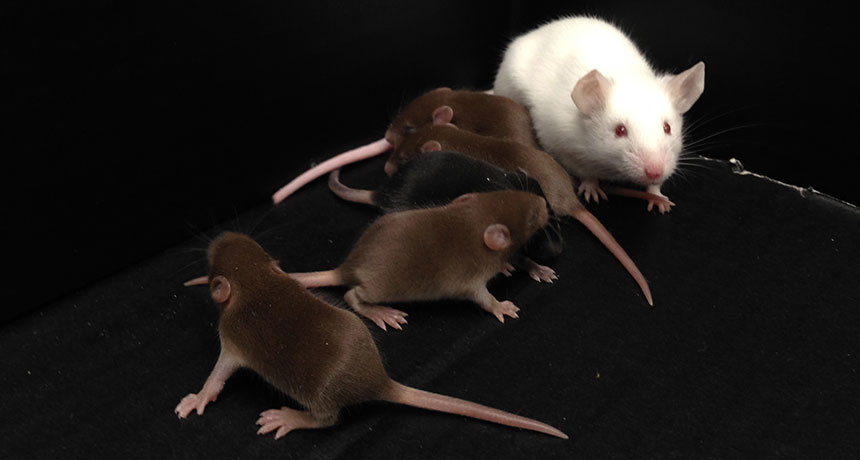Mice can be male without Y chromosome
Genetic manipulations enable female embryo to develop as opposite sex, study shows

MADE MALE This male mouse (white) has no Y chromosome, but was able to father pups (brown) when scientists injected his immature sperm into eggs. Researchers made the mouse male by manipulating genes on other chromosomes.
Yasuhiro Yamauchi
- More than 2 years ago
Researchers have created male mice with no trace of a Y chromosome, supposedly the defining hallmark of being male.
Reproductive biologist Monika Ward of the University of Hawaii in Honolulu and colleagues started with mice that have only one X chromosome (and no second sex chromosome). Normally those animals would develop as females. But when the researchers manipulated genes found on the X and another chromosome, the mice became males that could produce immature sperm. Those engineered males fathered offspring with reproductive assistance from the researchers, who injected the immature sperm into eggs, Ward and colleagues report in the Jan. 29 Science.
The experiments demonstrate that there are multiple ways to make males, says Richard Behringer, a developmental geneticist at MD Anderson Cancer Center in Houston. “They’ve done it without any Y chromosome gene information,” he says. “There’s not even a sniff of the Y around.”
At first glance, the experiments would seem to suggest Y chromosomes aren’t necessary for reproduction, which hints that evolution may eventually show Y’s the door. “To me it is a paradigm of the decline and fall of the Y chromosome,” says reproductive biologist Jennifer Marshall Graves of La Trobe University in Melbourne, Australia.
But Ward and other researchers say the Y isn’t going anywhere and that interpreting the new results as the chromosome’s death knell is wrong. Because the Y-less males needed help to reproduce, “clearly we need the Y chromosome for full natural male reproduction,” says Mary Ann Handel, a reproductive biologist at the Jackson Laboratory in Bar Harbor, Maine.
Ward and colleagues had previously shown that two Y chromosome genes — Sry and Eif2s3y — are crucial for male mouse development. Sry is a master gene that turns on male developmental programming in early embryos. It turns on a gene called Sox9, which then sets off a biochemical chain reaction that leads to male development.
But in the new experiments, the researchers turned on Sox9 through other means. Activating Sox9 in a genetically female embryo will cause it to develop as a male, Ward and colleagues found. But those males didn’t make sperm. “The testes were empty,” says Ward.
In order to produce sperm, mice need the Eif2s3y gene, the researchers had previously discovered. In the new experiment, the mice were missing the gene because they didn’t have Y chromosomes. So researchers substituted a similar gene from the X chromosome called Eif2s3x. Only one copy of the Y version is needed to make immature, tailless sperm, but it takes at least five copies of the X version to do the same thing. “This indicates that the Y chromosome gene is the strong one,” says Ward.
Her research suggests that the Y chromosome has optimized production from genes that are necessary for making males. Making just the right dose of male development factors is how the Y protects itself from evolutionary erasure, Ward says. “Our work does not support that the Y chromosome will disappear.”
Graves disagrees. Ward’s work is “a lovely example of how you can lose even a really important gene,” she says. At least two species of rodents have already jettisoned their Y chromosomes entirely. Primates, including humans, don’t have Eif2s3y genes on their Y chromosomes. No one yet knows whether Eif2s3y’s function in primates was taken over by other genes on the Y, its X counterpart or genes elsewhere in the genome. The new work may help explain how primates get along without the gene, Graves suggests, and the research may “give us useful information about what happens at the end of the life of the Y chromosome.”






